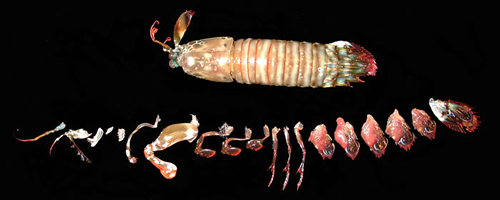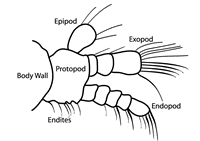







 Serial
homology of appendages as seen in a stomatopod.
From left to right appendages are: antennule, antenna, mandible, first
and second maxillae, first through fifth maxillipeds, 3 walking legs,
5 pleopods with pinkish gills, and uropod.
|
It has been suggested that arthropods, and likewise crustaceans, have survived and even thrived in all habitats and modes of living because of the versatility made possible by serial homology. Serial homology is the adaptation of a series of similar organs to have different functions. Crustacean appendages have adapted to function in sensing their environment, defending against predators, swimming, walking, grasping, transferring sperm, generating water movement, and in gas exchange.
 Generalized biramous crustacean appendage. Image used with permission from Karen Osborn, UC Berkeley. |
In the simplest condition, each segment of a crustacean posesses one pair of biramous appendages (see image, left). A biramous appendage is one that has two branches. Crustacean biramous appendages have a basal or first portion referred to as the protopod. (Proto means first or early, like prototype, and pod means foot, so protopodite means the first part of the foot). As you move away from the body on a biramous appendage you find a branch on the outside, the exopod (exo means outer), and a branch on the inside, the endopod (endo means inner). Sometimes the protopod has additional outgrowths besides the exo- and endopodites. These additional outgrowths are called epipods and endites depending on their location. In some crustacean groups appendages have large, flattened exopods, endopods, epipodites, and endites. Appendages with all of these outgrowths are called phyllopodus appendages and are found in several of the more ancient or primitive crustacean groups such as the Phyllocarida, Branchiopoda, and Cephalocarida.
Crustaceans are generally grouped by the number of segments they possess in each body region (head, thorax, and abdomen). The only appendages that all crustaceans have in common is two pairs of antennae. All others vary depending on the group. These differences in number of segments and function of appendages are used to distinguish between crustacean groups. In this table we summarize the names given to appendages of different functions, the sequence in which they generally appear on the body, and the region of the body they are found.
| Name | Region | Function | Comments | Other names used |
| Antennule | head | sensory | 1st antennae | |
| Antennae | head | sensory | 2nd antennae | |
| Mandible | head | crushing or grinding food items | jaw | |
| Maxillae | head | chewing and shredding food items | 1 or 2 pairs | acessory jaws |
| Maxilliped | thorax | manipulating food items | 0-3 pairs | |
| Pereopod | thorax | walking, clinging | as many as 5 pairs | walking legs |
| Pleopod | abdomen | respiration, swimming, holding offspring | natapods, swimmerettes | |
| Uropod | telson (last abd. segment) | protection, escape | tail fan |
